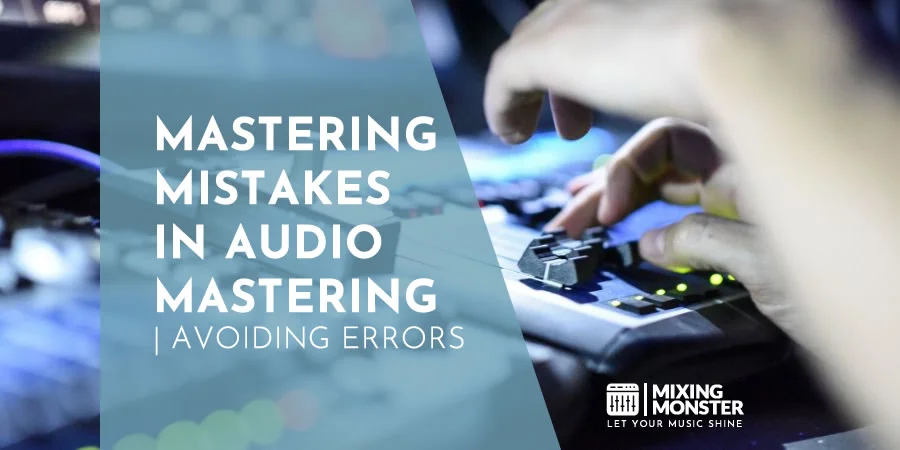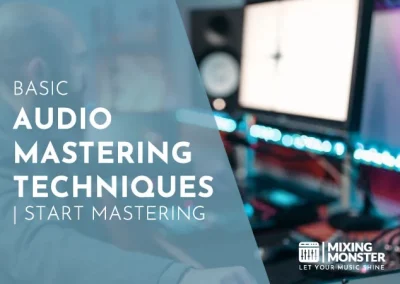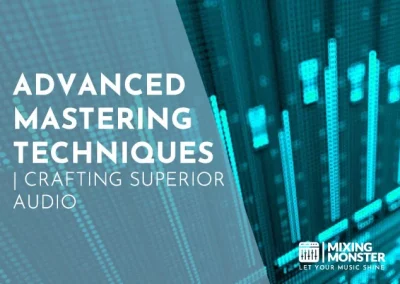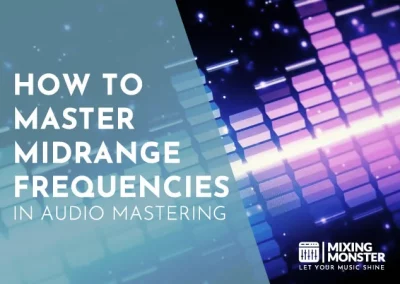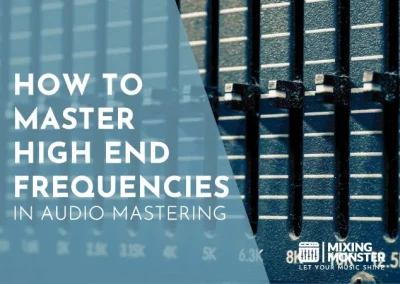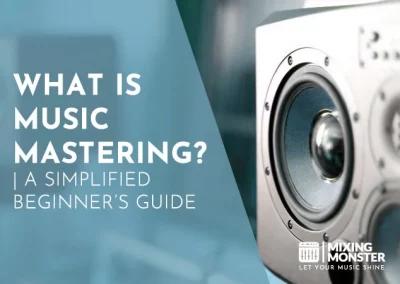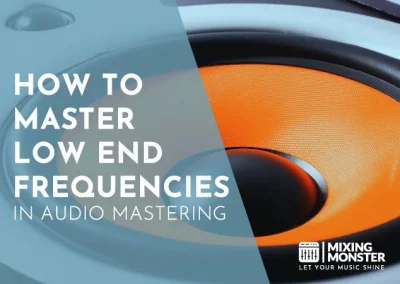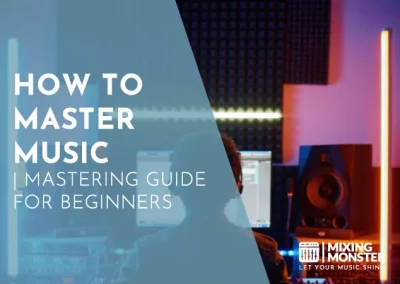Disclosure: Some of the links below are affiliate links, meaning that at no additional cost to you, we will receive a commission if you click through and make a purchase. Read our full affiliate disclosure here.
Mastering is the final step in the music production process, shaping the sonic character of a completed mix, but even skilled engineers can stumble. Mastering mistakes can introduce a slew of issues that detract from the quality of the recording, underscoring the need for meticulous attention to detail. Mastering audio is a complex process, and it’s crucial to identify and resolve typical mistakes.
Mastering requires a nuanced touch and a deep understanding of audio processing. Skilled mastering engineers employ various techniques to achieve a balanced and polished sound, including equalization, compression, and loudness optimization. Each step is critical in ensuring the track sounds its best across all playback systems.
As you delve into mastering, you must be aware of common pitfalls and how to avoid them. You’ll learn the importance of maintaining dynamics over succumbing to the loudness wars, the intricacies of spectrum balancing, and how to handle reverb in mastering. Insights into monitoring, room acoustics, and the value of reference tracks will guide your process. Technical knowledge will empower you to avoid digital glitches, and understanding the final revision stages will prepare you for quality control.
KEY TAKEAWAYS:
- Mastering is a critical final touch that can make or break a track’s sound.
- A range of techniques is necessary for audio balance and technical quality.
- Common mastering errors are preventable with knowledge and careful practice.
Table Of Contents
1. The Pitfalls Of Loudness Wars
2. Spectrum Balancing In Audio Mastering
3. The Missteps Of Mastering Reverb And Effects
4. Monitoring And Room Acoustics
5. Overlooking Reference Tracks In Mastering
6. DIY Mastering Without Proper Knowledge
7. Technical Errors And Digital Glitches In Mastering
8. The Final Check: Quality Control And Revision In Mastering
9. Avoiding Common Mastering Pitfalls
10. FAQ

1. The Pitfalls Of Loudness Wars
In striving for competitive volume levels, you risk falling into the trap of the Loudness Wars, a trend that has ironically led to decreased audio quality across the industry.
The Lure Of Over-Compression In Audio Mastering
Over-compression in audio mastering is tempting as it makes your track sound louder, but it often comes at the cost of dynamic range. This excessive compression can strip away your music’s dynamics and subtle nuances. Nothing stands out when every element is loud, resulting in a flat, lifeless track.
How Loudness Affects Dynamics And Clarity
As loudness increases, dynamic range—the difference between the softest and loudest parts—often decreases. This reduction in dynamics can lead to a loss of clarity and detail in the music. Your tracks may sound powerful, but with the loudness war pushing you to the limits, you’ll find it increasingly difficult to maintain clarity and punch in your mixes.
Strategies To Achieve Optimal Loudness Without Sacrificing Quality
It would be best if you had control over your compression and limiting techniques to achieve optimal loudness without sacrificing quality. Consider using loudness normalization, which allows different tracks to play back at a similar volume without drastic increases in gain.
This approach helps maintain the integrity of your dynamics while staying competitive in the book. Remember, loudness is not the only measure of a great track; aim for a balance between volume, clarity, and warmth.
2. Spectrum Balancing In Audio Mastering
Achieving a well-balanced spectrum in audio mastering is crucial for a polished and professional sound. Mastering involves fine-tuning your mix’s balance across the entire frequency spectrum while considering the stereo field to create depth and movement.
Identifying And Correcting Frequency Imbalances
During mastering, your primary task is to identify and correct frequency imbalances. Mastering EQ enhances or attenuates specific frequencies to achieve a balanced mix. Remember, changes should be subtle; broad strokes are for mixing. Watch out for overemphasizing particular frequencies, which can mask others, leading to a muddy or piercing mix.
The Consequences Of Neglecting The Stereo Field
Neglecting the stereo field can result in a flat, lifeless mix. Effective stereo imaging ensures that each element sits perfectly within the stereo field, contributing to a sense of width and space. Use panning judiciously and check the mono compatibility regularly, as drastic panning can cause phase issues and loss of focus in the mix.
Utilizing EQ And Stereo Imaging Tools In Audio Mastering
Incorporate mastering tools to sculpt the tonal balance and widen the stereo image. Mastering EQs provides precision to address specific issues, while stereo imaging tools can enhance the stereo field. When applied skillfully, these tools contribute to a master that translates well across various playback systems. Choose your tools wisely; each has its character and purpose within your mastering chain.
3. The Missteps Of Mastering Reverb And Effects
Mastering reverb and effects holds great power for both enhancing and impairing a track. In this section, you’ll discover how to navigate the pitfalls of reverb and effects usage to maintain clarity and depth in your masters.
Common Misuses Of Reverb In Mastering
Reverb is crucial for adding space and dimension to a mix, but its misuse can bring unwanted results. A frequent mistake is the blanket application of reverb to an entire track, which can wash out the detail and texture of individual elements.
Instead, consider the specific needs of each section and how reverb might enhance the signal chain without overwhelming it. An article on Whipped Cream Sounds explains the nuance required when enhancing the tail of instruments or a track, warning against an abruptly cut mix.
Achieving Depth Without Muddiness In Mastering
Creating depth does not necessitate the sacrifice of clarity. One key strategy is selective reverb timing and choice—applying different reverbs or decay times to certain elements can carve out space in the mix.
The goal is for reverb to complement the track’s ambiance, not confuse it. For instance, using a shorter reverb tail on faster-paced sections can prevent a muddy build-up, preserving the energy and articulation needed.
Inappropriate Use Of Effects In The Mastering Chain
When integrating effects in mastering, each addition should serve a purpose and enhance the final product. Over-processing with unnecessary or exaggerated effects can strip away the nuances and degrade the overall dynamism of a mix.
A compelling piece of advice from iZotope suggests that ambiance closely tied to a sound may benefit more from track-based reverb than applying reverb on a bus, as it maintains the element’s integrity in the mix.
4. Monitoring And Room Acoustics
Accurate monitoring and room acoustics are pivotal in mastering audio. They directly impact how sound is perceived and can either enhance or compromise the precision of your work.
The Role Of Accurate Monitoring In Mastering
Accurate monitoring ensures that the audio frequencies in your mix are represented truthfully, allowing you to make informed decisions about balance and EQ. While headphones provide a helpful reference, loudspeakers are essential to appreciate the stereo image and depth of the mix. Setting monitoring levels carefully is crucial; too loud can cause ear fatigue, while too soft may not reveal all the details.
How Room Acoustics Can Deceive Your Ears
Your room can introduce unwanted coloration into your listening experience, misleading your mixing choices. Bass frequencies can build up in corners and misguide you about the low-end balance of your mix, while reflections from walls can create phase issues, leading to a misguided sense of stereo spread. Visiting resources like Understanding Room Acoustics and Sound Treatment can help demystify these problems.
Tips For Setting Up A Reliable Mastering Environment
Begin with speaker placement—form an equilateral triangle between your speakers and your listening position. Use acoustic treatments such as bass traps and diffusers to reduce resonances and reflections.
Calibrating your speakers to a consistent sound pressure level is also vital for comparative purposes. Consider references like Studio SOS Guide To Monitoring & Acoustic Treatment for further insights into optimal room setup and treatment practices.
Remember, your goal in mastering is to create a final product that sounds good on all playback systems. Your monitoring environment is critical in ensuring the objective is met.

5. Overlooking Reference Tracks In Mastering
In mastering, reference tracks are essential tools that provide a sonic benchmark. Neglecting their use can lead to a master that lacks competitiveness in clarity, balance, and impact within your genre.
How Reference Tracks Can Guide Your Mastering Process
Using reference tracks effectively illuminates a path to sonic excellence. They allow you to gauge the spectral balance and dynamic range of your master against proven standards. For instance, by closely analyzing a well-mastered track in your genre, you can discern how much low-end presence is appropriate or how crisply the high-end should be articulated.
Selecting The Right References For Your Genre
Choosing appropriate reference tracks is as crucial as their utilization. Ensure your selection mirrors the genre and desired sound of your track.
A track with a solid and cohesive low-end might be suitable for electronic music mastering, whereas, for rock music, something with more dynamic guitar sounds might be preferable. These benchmarks set a consistent target for tonality and dynamics.
A/B Testing Your Master With Professional Tracks
Consistent A/B testing during your mastering session can highlight discrepancies and guide adjustments. Alternating between your master and high-quality reference tracks provides immediate feedback on where your master stands, allowing for precise, informed changes that ensure your track measures up in level and EQ balance.
6. DIY Mastering Without Proper Knowledge
Mastering is the final step in music production and requires a critical ear and technical expertise. Embarking on DIY mastering without proper knowledge can lead to substandard results and harm your music’s potential.
When To Master Yourself And When To Hire A Pro
You may choose to master your music if you are working with a limited budget or desire full creative control. However, hiring a professional mastering engineer is crucial when you seek an unbiased perspective and expert mastery of sonic elements. Masters crafted by a professional can ensure your music competes with the industry standards, maintaining both fidelity and dynamics.
Educational Resources For Improving Mastering Skills
Improving your mastering skills mandates dedication to education. Consider our online tutorials, workshops, and articles such as the insightful guide on DIY Mastering for practical steps and technical details. Additionally, interactive platforms, like iZotope’s learning tools, offer ten tips for mastering even if you’re not a mastering engineer, which can help build a solid foundational skill set.
The Benefits Of Professional Mastering Services
Professional mastering services bring numerous benefits. Foremost among these is the application of finely-tuned equipment and experienced ears in assessing and adjusting your tracks. This can enhance the audio quality dramatically, ensuring that your music translates well across various listening environments. Engaging a professional often means acquiring a polished and cohesive sound that only years of mastering work can achieve.
7. Technical Errors And Digital Glitches In Mastering
Mastering your music is the final step in production, but it can introduce technical errors and digital glitches if not done correctly. You’ll need to be on the lookout for common digital audio artifacts, understand your bit depth and sample rate settings, and ensure you avoid clipping to maintain sufficient headroom.
Identifying Common Digital Audio Artifacts And Distortion
Listen intently for digital artifacts such as aliasing or quantization noise when mastering your tracks. Distortion can also creep in if the signal chain is not pristine. These are often the result of:
- Poor Quality Conversion:
Converting audio files with low-quality equipment or software can introduce unwanted noise. - Excessive Processing:
Overuse of effects like compression or EQ can produce artifacts.
Understanding Bit Depth And Sample Rate Settings
Your bit depth and sample rate are critical in determining the resolution of your audio. Failure to set them correctly could lead to a range of problems:
- Bit Depth Too Low:
A low bit depth can lead to quantization error, which creates a faint but noticeable granular noise, robbing your music of its subtlety. - Sample RateMismatch:
Ensure your sample rate matches the project settings to avoid unnecessary resampling, which can degrade audio quality.
How To Avoid Clipping And Ensure Headroom
To prevent clipping, the most important rule is to monitor your levels constantly throughout the mastering process. It would help to aim for a peak level that does not exceed 0 dBFS, leaving enough headroom for dynamic content.
- Track Peaks:
Use a metering plugin to track peaks accurately. - Apply Limiting Wisely:
A limiter can help manage peaks, but over-limiting can squash dynamics and introduce distortion.
8. The Final Check: Quality Control And Revision In Mastering
Quality control and meticulous revision are paramount in mastering. Your final music product should be as error-free and sonically polished before release. Let’s examine how to optimize quality control and ensure your master is ready for listeners.
The Importance Of Fresh Ears And Multiple Listening Sessions
Employing a fresh set of ears is crucial in identifying nuances that may be overlooked. It’s highly recommended to step away from your project and return with a clear perspective.
Moreover, listening to your master across various sound systems and environments can reveal inconsistencies that need your attention. This approach ensures a well-rounded quality check and enhances the final product’s universal playback quality.
Seeking Feedback Before Finalizing The Master
Before you finalize your master’s, seek feedback from trusted peers or professionals in the industry. Fresh perspectives provide invaluable insights and may catch potential issues you’ve become audio-blind to. Take notes of the feedback to assess what may require a revision.
- Peer Review:
Share with at least three trusted individuals - Professional Critique:
Consider consulting a seasoned mastering engineer
Soliciting critiques sharpens the finalizing process, paving the way toward a more polished and universally accepted master.
Revising And Polishing The Master For Perfection
Revising and polishing is not about overhauling your work but refining it to perfection. Subtle changes often make the most significant difference, whether EQ tweaks, leveling, or dynamic adjustments. Make revisions in a controlled environment to assess and enhance audio quality accurately. Your end goal is a master that is transparent, dynamic, and true to your artistic vision.
- EQ Tweaks:
Adjust frequency balance for clarity. - Level Adjustments:
Ensure consistent volume throughout. - Dynamic Processing:
Optimize compression and limiting for punch and dynamics.
9. Avoiding Common Mastering Pitfalls
Mastering audio can be a nuanced process, and being aware of and avoiding common mastering mistakes is crucial for achieving a professional sound.
Mastering Mistakes: Key Takeaways
Mastering Mistakes to Avoid
| Mistake | Consequence | Avoidance Tip |
|---|---|---|
| Overcompression | Loss of dynamics | Use compression sparingly and with intention |
| Excessive EQ | Unnatural sound balance | Apply subtle EQ adjustments and A/B test |
| Improper gain staging | Clipping and distortion | Maintain optimal input and output levels |
| Neglecting monitoring environment | Inconsistent mixes | Invest in accurate monitors and treat your room |
Remember to focus on preserving the integrity of the mix while enhancing its overall sound.
Continuous Learning And Practice In Mastering
Your mastering skills will improve with time. Engage in continuous learning and practice; study mastered tracks in your genre and apply your findings to your work. Gathering feedback from experienced engineers can also provide valuable insights to refine your approach.
Final Thoughts On Avoiding Mastering Mistakes
Remember that mastering is an art—if a mistake is made, assess the impact on the track and determine if it aligns with your artistic intent. Trust your ears and rely on objective measurements to guide your decisions.
Happy mastering!
10. FAQ
1) How can you recognize and correct common errors in audio mastering?
To identify errors in audio mastering:
- Listen for signs of imbalance in EQ, overuse of compression, or a lack of dynamic range.
- Correct these issues by employing moderate EQ adjustments, using compression sparingly, and ensuring proper dynamic range throughout your track.
- Use reference tracks to compare your track against industry-standard ones.
2) What techniques should be adopted to avoid over-compression during mastering?
Avoid overcompression by setting conservative compression thresholds, using longer attack times to preserve transients, and keeping the ratio low. It’s also beneficial to A/B test your master with the uncompressed mix to hear the impact of your compression settings.
3) In what ways can mastering at excessive volume levels impact the final sound?
Mastering at too high a volume can lead to ear fatigue, which may result in a biased judgment of the music’s dynamics and a flat-sounding mix. It also increases the risk of introducing unwanted distortion or clipping into the final product.
4) How can you tell if the mastering process has degraded the original mix?
If the original mix’s clarity, depth, or balance is compromised post-mastering, the process has likely degraded it. Compare your master to the original mix at equal loudness levels to determine if audio fidelity has been lost.
5) Which indicators suggest that mastering quality has been achieved?
Mastering quality is achieved when the final master is transparent, enhancing the mix without introducing artifacts. The audio should sound balanced across all playback systems and have sufficient headroom without clipping or distortion.
6) Why might mastering appear challenging, and what steps can you take to simplify the process?
Mastering may seem daunting due to its precision and the subtle adjustments involved. Simplify the process by systematically applying changes, referencing professional tracks, and using high-quality monitoring equipment to hear the impact of your mastering decisions accurately.

